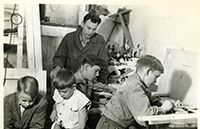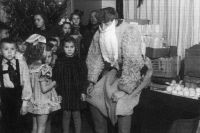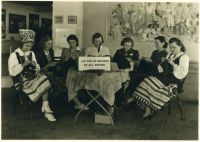Children in DP camps
It is estimated that children made up at least 20% of the Estonian population that reached Germany. Due to the fact that there were so many children in the camps, parents immediately began to think about the child-related activities. Quickly, all possible efforts were made to create a nursery for pre-school children and a curriculum for school aged children. Possibility of continuation of education in their native language was highly valued. Estonians DPs easily ran this kind of organisation with professional skills. Finding the necessary facilities and sourcing materials was more challenging, but with the support of the camp administrators, even this problem was overcome.
In the autumn of 1945 there were 207 pre-school children and three kindergartens were opened in Geislingen. Kindergartens accepted children that were at least three years of age. They partook in a traditional kindergarten programme: everything from reading and writing to handicrafts, singing and gymnastics. Kindergarten children received extra food like milk powder, biscuits, and candy, which had to be consumed on the spot. Milk was made from milk powder for the large camps, and the so-called milk kitchens materialised under the orders of the UNRRA from the summer of 1946 to the summer of 1947. While parents protested against the milk kitchens constantly, this remained unchanged until August 1947, when the decision was made by the IRO to give whole milk to children.
There were 216 primary school children from 1945–46, 408 a year later, and 505 at the peak point from 1947–48 in Geislingen. There were over 200 children in high school each year, though those numbers began to decline in 1949 due to relocation. The average age of students was older in each year compared to back home, as many had left school early because of the war. One in three high school students had lost a father, every sixth a mother, and every seventh both parents. At the end of the 1945–46 school year there were 1164 students in primary schools and 580 high school students in the US zone. There were approximately 800 students in primary schools and 500 in high schools in the British zone.
In addition to regular schools, there were music schools in the DP camps as, for instance, Hanau, Kleinheubach, Hameln, Amberg and Geislingen. In January 1946, it was possible to learn piano, string instruments, brass instruments, and singing at Geislingen.
Thanks to the UNRRA and international missions, the camps were supplied with clothing, foodstuffs, medicine, and other necessities. For example at Geislingen camp, children were given cotton and woollen dresses, coats, pullovers and trousers, as well as basic t-shirts, socks, shoes, and workout clothes. Food rations for DPs in the autumn of 1945 amounted to 2,300 calories per day per person. In 1946 they changed according to age groups, with minimised normal consumer food rations, but the children, young people and workers received some food additives.
| Young handymen at woodwork in a DP camp in Germany, probably in 1945. VEMU FK.61-15 |
|
| Christmas celebration in DP camp in Amberg, December 1948. VEMU FK.61-41 |
|
| Estonian women making handicraft for all the children in DP camps in 1946. VEMU FK.61-113 |




